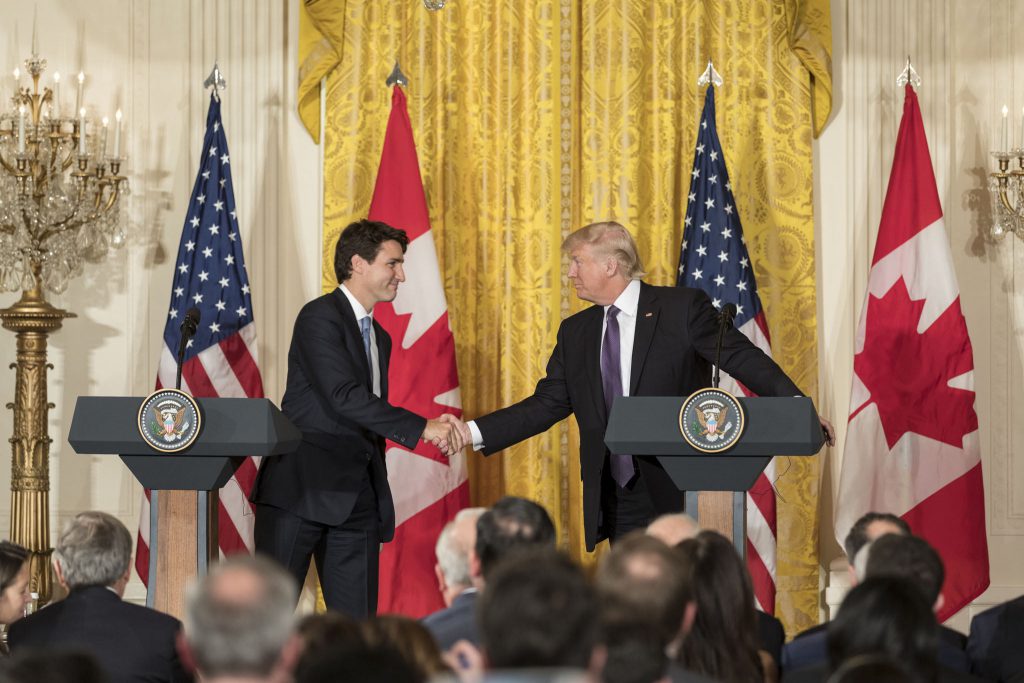
U.S. and Canada reach an agreement at the 11th hour. Literally.
The North American Free Trade Agreement (NAFTA) lives — under a new name, anyway.
Leaders from the United States, Canada, and Mexico announced on late Sunday night that they reached an agreement to update NAFTA, the trilateral trade deal that President Trump long has wanted to overhaul. The announcement came just before a self-imposed midnight deadline to get the deal done, and literally at the 11th hour: The White House held a conference call with reporters at 11 p.m. Eastern time.
In typical Trump fashion, the new NAFTA has new branding: It’s now called the United States-Mexico-Canada Agreement, or USMCA.
It’s an exciting development, and one that many astute observers didn’t expect was possible just a few days ago. But don’t break out the champagne quite yet.
While all three USMCA leaders are expected to sign the accord within 60 days — including, crucially, the outgoing Mexican president —Congress also needs to approve the new pact, as do legislative bodies in Mexico and Canada. In the United States, congressional approval isn’t a guarantee, especially if Democrats regain control of the House of Representatives following the midterm elections in November.
Here at the Alliance for American Manufacturing, we are going to reserve our judgment on the new USMCA until we’ve had some time to fully review it. But a few key details about the agreement stand out, as the Washington Post reports:
- Autos: In order to qualify for zero tariffs, an automobile must have 75 percent of parts made in the U.S., Canada or Mexico. This is a boost from the current 62.5 percent requirement. Starting in 2020, at least 30 percent of the work done on the auto must also be completed by workers earning at least $16 an hour, three times what the typical Mexican autoworker makes. In 2023, that percentage increases to 40 percent for cars.
- Auto Tariffs: Throughout the negotiating process, Trump threatened to levy big tariffs on autos and auto parts if a deal wasn’t reached. But as part of the new agreement, the U.S. signed “side letters” with Canada and Mexico that will allow them to mostly bypass auto tariffs.
- Steel: One of the points of contention in the talks was the Trump administration’s Section 232 action on steel imports; Canada wants the U.S. to drop its 25 percent tariff on Canadian steel. In a side letter, the U.S. and Canada agreed that the U.S. "shall not adopt or maintain a measure imposing tariffs or import restrictions on goods or services of Canada under Section 232… for at least 60 days after imposition of a measure." The two countries would then negotiate "an appropriate outcome" over those 60 days. How this all impacts the current tariffs remains unclear, however, and a White House official said Sunday talks are ongoing on a "separate track."
- Labor and Environment: Improvement in these areas is crucial if the Trump administration hopes to get any support from Democrats and labor unions. The Post notes a few details, including higher safety regulations for Mexican trucks that enter the United States. Mexican workers also are given more ability to organize and form unions.
- Intellectual Property Protection: Given that the original NAFTA was negotiated in the early 1990s, its intellectual property (IP) regulations were woefully outdated. As such, there are a number of new IP guidelines in the USMCA designed to better protect company trade secrets and other IP.
We’ll have more thoughts and analysis on the USMCA in the coming hours and days, so stay tuned.
And as the effort now moves to Congress, we’ll point out that voters are pretty clear about what they’d like to see out of the new deal: Higher wages, strong alliances, penalties to prevent trade cheating, maximizing the use of U.S. parts in autos and other products, and a reduction in the trade deficit. Whether the new USMCA will be able to deliver remains to be seen, and might just be key to winning congressional approval.
